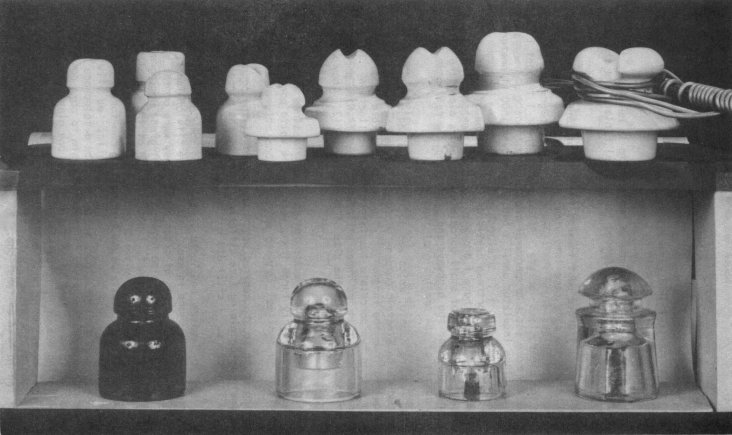Insulators of Finland
by William J. Hill
Reprinted from "INSULATORS - Crown Jewels of the Wire", November 1973, page 3
On my most recent vacation trip to Finland I noticed, of course, the
Insulators (ERISTEET, Insulators in Finnish language) were mostly made of white
porcelain.
I rented an English make Sunbeam Hunter auto in Helsinki, the capital of
Finland, and I headed for central Finland and the North Country.
From Helsinki I drove east towards the city of Lappeen Ranta, and just before
the city came into view, I noticed some small glass signal type in use along the
lines close to the highway. They were the clear glass variety. After seeing
these I thought I would see a lot more in other parts of the country. But I did
not see another glass Insulator until I had driven over 1500 kilometers.
I visited the old fortress castle of Olavin Linna at the town of Savon Linna.
From there I drove to Kuopio in central Finland. I looked at millions of small
porcelain insulators along the telephone lines near the highways and also along
the railroads. They were mostly of the small signal type.
After leaving Kuopio, which was quite a large and quaint city, I noticed
three electric company employees out along their lines. I inquired from the
foreman if it would be possible to obtain at least one or two porcelain
insulators for my collection. To my surprise, they gave me three different types
of white porcelain power insulators about the size of Hemingray D-512. They were
embossed ARABIA.
I noticed that all of the insulators along the lines as far north as Kuusamo,
a fairly large town, were of the white porcelain variety.
Heading south to the central and western part of the country, I was fortunate
in obtaining five different types of the porcelain telephone insulators. I still
did not own a glass one.
On my way to Tampere and Turku I noticed on some of the poles the clear glass
insulators in use. South of the city of Tampere there were two different types
of clear ones. They were of the signal type. Once in awhile I also noticed a
light green Hemingray CSA type. Then, to my amazement, I noticed some of the
signal type were amber color. But the poles were quite high, and there was not
even a remote possibility of me ever getting one for my collection.
But, to my good fortune, there happened to be a telephone lineman at work on
one of the poles. I called for him to come down, which he did. I tried my best
to have him get me one glass insulator, even offering one of my porcelain in
exchange. But to no avail. He did not accept my offer. But he did advise me as
to how I might obtain some of the glass , which to me by now were very scarce. I
just had to have at least one. They were at the next town nine kilometers away.
I was to contact the telephone company. Upon arriving, and with a little
difficulty finding the telephone company, to my astonishment, I was taken to
their warehouse, where I acquired four different types of glass insulators, two
clear and one amber and also one of the light green variety.

The porcelain of Finland are embossed ARABIA. They are manufactured at the
Arabia plant in Helsinki. This plant also manufactures fine china and pottery.
The glass insulators of Finland are mostly unembossed. Only one that
I-obtained had KARHULA - HEL 2 embossed on the skirt. The glass insulators are
manufactured by the Riihi Maki Glass Co, Riihi Maki, which is located seventy-five kilometers north of Helsinki.
Being able to speak the Finnish language enabled me to acquire these
insulators. Very few people in Finland understand English, let alone speak it.
However, the English language is now being taught in the Finnish schools.
There are no insulator collectors in Finland, and I found out no one had ever
heard of the hobby. I did see some antique bottles in antique stores.
The porcelain power insulators of Finland have the standard pin hole of our
American variety. However, the porcelain telephone type have a very small pin
hole slightly smaller than our Surge.
The glass insulators of Finland are of the threadless variety.
The insulator pins are all of the metal type, quite similar to those used in
this country. I did not see a wooden insulator pin in Finland.
On the preceding page is a photograph showing the "Insulators of
Finland". Top row, from left to center: Telephone ceramic insulators
embossed ARABIA. From center to right: Power ceramics, also embossed ARABIA.
Bottom row, from left: No name amber, No name clear, small Signal embossed
KARHULA HEL. 2, light green No name similar to Hemingray CSA type.
| 